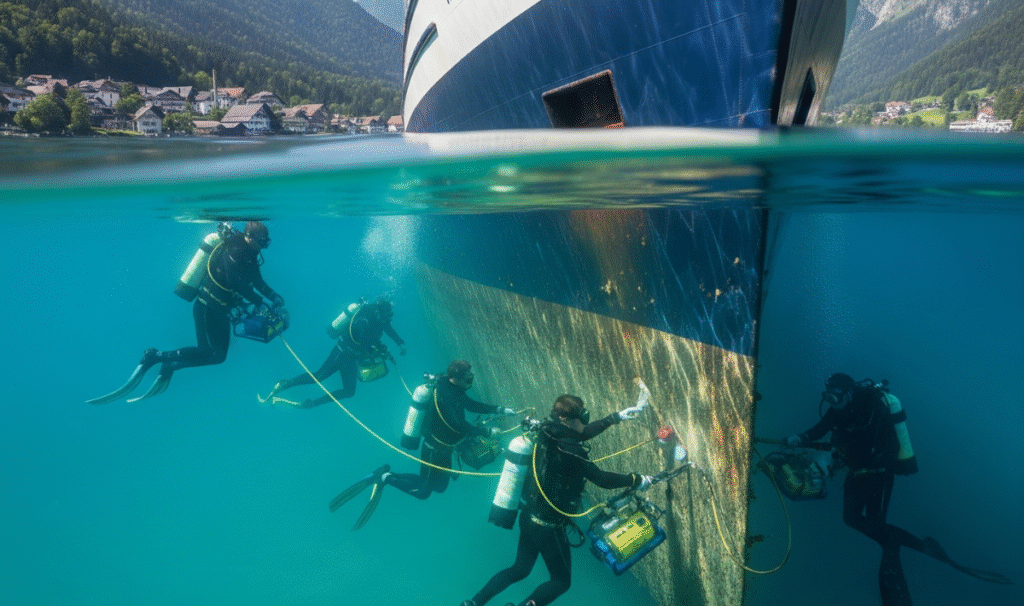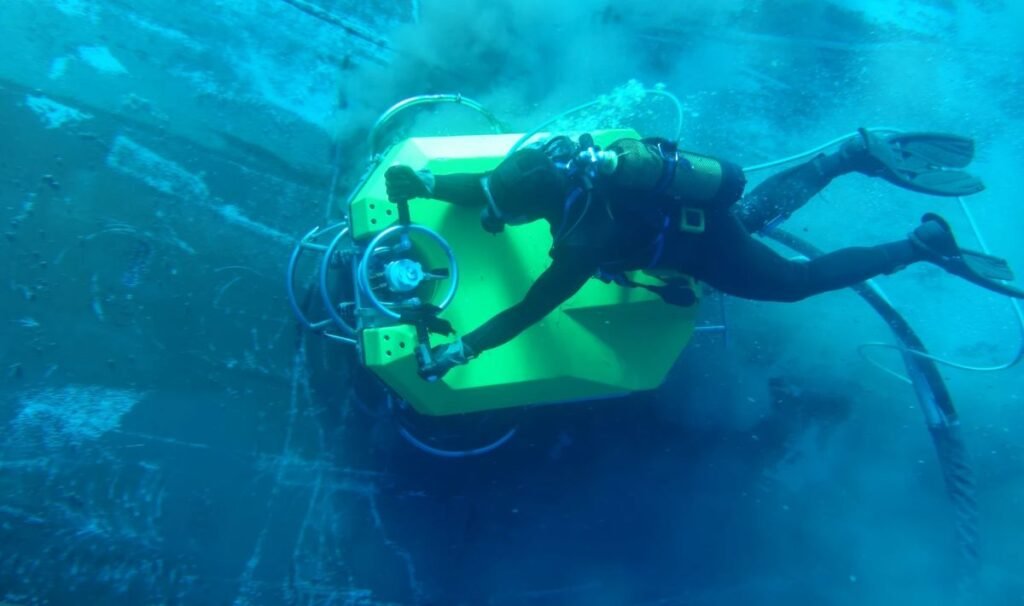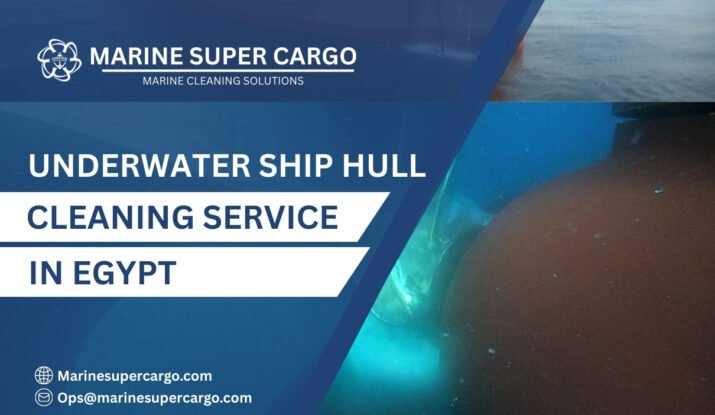Imagine steering your vessel along the sunlit coast of Alexandria or through the busy lanes of Suez, confident that every knot of speed is earned and every cent on fuel goes the distance. This is the promise of Underwater Ship Hull Cleaning in Egypt—a strategic move that transforms sluggish ships into swift, efficient moneymakers, all while keeping the marine playground safe for future generations.
Egypt stands at a maritime crossroads. Ships crisscross between the Mediterranean and Red Sea, lining up for global trade. With such bustling routes, vessels are magnets for marine growth—barnacles, algae, and tough encrusters that quickly blanket hulls, eating away at efficiency and profit.
Why Underwater Ship Hull Cleaning in Egypt is Critical
Biofouling and the Rising Cost of Fuel
Biofouling is more than a cosmetic nuisance. Imagine running a race with bricks tied to your ankles; fouled hulls increase drag, sometimes shooting fuel use up by 20–40%. Over months and thousands of nautical miles, the cost is crippling. That’s why global initiatives, supported by organizations like the International Association of Ports and Harbors (IAPH), emphasize better hull maintenance as a pathway to both economic savings and greener shipping.
The Environmental and Legal Imperative
Egypt follows International Maritime Organization (IMO) regulations as well as local environmental codes. Hulls thick with marine life don’t just slow ships—they can transfer invasive species, disrupt fragile Mediterranean and Red Sea ecosystems, and trigger penalties or port delays. Eco-friendly, compliant cleaning isn’t just good citizenship—it’s good business.

What Grows on Egyptian Hulls? Common Marine Fouling in the Mediterranean and Red Sea
Egyptian waters are fertile ground for barnacles, tube worms, mussels, calcareous algae, and complex biofilms. Especially in warm, shallow port waters, growth is rapid. Stopping for a few days can be all it takes for a “green beard” of algae or a stubborn barnacle army to emerge.
Leading Underwater Ship Hull Cleaning in Egypt: Technologies Used
Diver-Based Cleaning
Professional diver teams remain a mainstay. Armed with brushes and scrapers, they remove biofouling while preserving anti-fouling paint. Detailed inspections—before, during, and after cleaning—help spot hull damage early and fine-tune your maintenance schedule.
Brush Kart Systems and Magnetic Robot Crawlers
For large or heavily fouled ships, hydraulic brush kart systems are the heavy hitters. These machines use powerful rotating brushes, clinging to the hull with strong suction. Cleaning rates are impressive—thousands of square meters in under a day, keeping big tankers or containerships on schedule. Robots like magnetic hull crawlers are gaining ground too, offering remote operation and exceptional precision.
High-Pressure Water Blasting and Innovative Methods
High-pressure water jets strip biofouling—even tough barnacle clusters—while protecting hull coatings when used by trained specialists. Many Egyptian companies are also exploring eco-friendly gels and soft “grooming” brushes for gentle, frequent cleaning, minimizing the need for reactive, high-force treatments.
Process For Underwater Ship Hull Cleaning in Egypt: Step-by-Step in Egyptian Ports
- Initial Inspection: Divers or underwater robots survey the hull, generating photographic and video records to map fouling.
- Cleaning Procedure Planning: Teams select the right method (manual, kart, robot) and ensure environmental protection measures. The vessel crew is briefed on safety.
- Fouling Removal: Divers or machines methodically scrub or blast away the marine growth, focusing on propellers, rudders, intake grates, and hull plates.
- Waste Capture and Disposal: Leading providers use suction and filtration to prevent debris from harming port waters; all materials are disposed of according to Egyptian and IMO rules.
- Final Survey and Reporting: Post-cleaning inspections ensure not only a job well done, but proper documentation for compliance and insurance.
Key Ports and Service Providers for Underwater Ship Hull Cleaning in Egypt
Alexandria, Port Said, Damietta, and Suez are Egypt’s major maritime gateways. Underwater ship hull cleaning in Egypt specialists like Cleaniship.co offer comprehensive cleaning, inspection, and even rapid underwater repairs. Expect a blend of local know-how and international standards.
How to Select a Partner For Underwater Ship Hull Cleaning in Egypt
- Ensure teams have proper diver certifications and modern equipment (brush karts, ROVs).
- Look for companies that offer transparent, photo-documented reports.
- Confirm that providers follow waste management protocols and are pre-approved by local port authorities.
- Check for extra services: propeller polishing, anode replacement, and rapid-response repairs are valuable add-ons.
Chemical and Physical Impacts: Safety for Paint, Crew, and Environment
Cleaning isn’t just about removing growth; it’s about doing it safely. Too-harsh brushing or blasting can strip expensive coatings, while careless waste disposal pollutes harbors. The best Egyptian providers balance thorough cleaning with gentle methods and strict environmental discipline, saving on both repainting and regulatory headaches.
Routine Maintenance Schedules: When and Why to Clean
Don’t wait for performance to dip. Regular hull cleaning—every 3–6 months, or more frequently for heavily trafficked or long-idling ships—keeps fouling at bay and stops expensive build-up before it starts. Following best practices aligned with MARPOL helps shipowners ensure compliance while reducing environmental impact.

Benefits of Regular Underwater Ship Hull Cleaning in Egypt
- Fuel Savings: Smooth hulls = less drag = lower running costs.
- Speed and Schedule: Minimal fouling means reliably timed arrivals and departures.
- Longer Hull and Paint Life: Regular cleaning preserves anti-fouling coatings and delays the need for costly dry dockings.
- Regulation Ready: Stay on the right side of Egyptian and global authorities.
- Early Detection: Routine inspections prevent small issues from ballooning into big, expensive nightmares.
Conclusion:
Underwater ship hull cleaning in Egypt is more than a maintenance routine—it’s a core business investment. Embrace new tech, partner with seasoned pros, and keep your hull slick, your shipping sustainable, and your profits secure. In the high-stakes world of Egypt’s shipping lanes, a clean hull isn’t just an advantage—it’s a necessity.
FAQ:
Q1. How often should ships undergo underwater hull cleaning in Egypt?
Most vessels benefit from cleaning every 3–6 months, with more frequent service for idle or slow-moving ships.
Q2. Which ports in Egypt offer professional hull cleaning services?
Alexandria, Damietta, Suez, and Port Said lead the way, with reputable providers operating in each.
Q3. Will underwater cleaning damage my ship’s paint or coating?
Not when using certified divers and modern equipment—gentle, targeted cleaning preserves coatings and saves money.
Q4. Can cleaning take place during cargo loading or only when idle?
Many service providers coordinate cleaning during loading or unloading, minimizing downtime and maximizing efficiency.
Q5. What happens to the marine growth removed during cleaning?
Environmentally responsible companies use waste collection and filtration systems, ensuring no pollution enters Egyptian waters.


